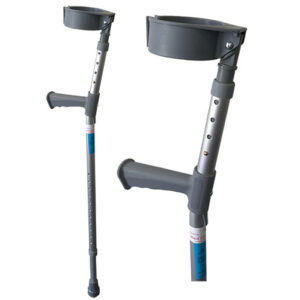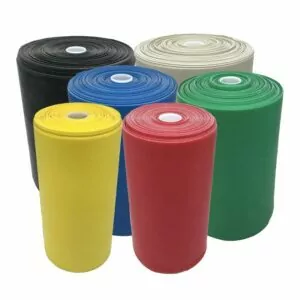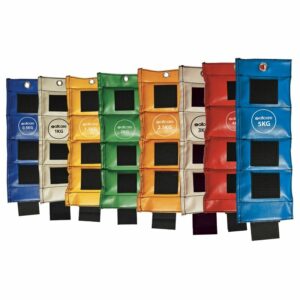Gluteal Strain
Updated:
(Also known as Gluteal Tear, Buttock Strain, Torn Gluteal Muscle)
What is a gluteal strain?
A gluteal strain is a condition that is rarely seen in clinical practice and is characterized by tearing of one or more gluteal (buttock) muscles.
The gluteal muscles are a strong group of muscles situated at the back of the pelvis forming the buttock (figure 1). The gluteals primarily comprise of 3 major muscles including:
- Gluteus maximus
- Gluteus medius
- Gluteus minimus
These muscles originate from the pelvis and insert into the top of the thigh bone (femur) (figure 1). The gluteal muscles are primarily responsible for straightening the hip during activity, stabilizing the pelvis and assisting with outer movements of the hip (e.g. taking the leg to the side or changing direction when running). They are particularly active during running, jumping, squatting and lunging. During contraction of the gluteals, tension is placed through the gluteal muscles. When this tension is excessive due to too much repetition or high force, one or more of the gluteal muscles can tear. This condition is known as a gluteal strain.
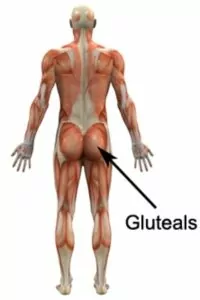
Tears to the gluteal muscles can range from a small partial tear whereby there is minimal pain and minimal loss of function, to a complete rupture. Gluteal strains range from a grade 1 to a grade 3 tear and are classified as follows:
- Grade 1: a small number of fibers are torn resulting in some pain, but allowing full function.
- Grade 2: a significant number of fibers are torn with moderate loss of function.
- Grade 3: all muscle fibers are ruptured resulting in major loss of function.
The majority of gluteal strains are grade 2 tears.
Causes of a gluteal strain
Gluteal strains usually occur due to a sudden contraction of the gluteal muscles often when they are in a position of stretch. This sometimes occurs with rapid acceleration whilst running (particularly up hills), when performing an explosive jump or when lifting excessive weight (e.g. loaded squats or lunges in a gym). Gluteal strains are occasionally seen in running and jumping sports such as football, basketball, soccer, rugby, and athletics (particularly sprinters, hurdlers, and long jumpers) or during weight training. Gluteal strains tend to occur more commonly in the older athlete and particularly following an inadequate warm-up.
Signs and symptoms of a gluteal strain
Patients with a gluteal strain usually feel a sudden sharp pain or pulling sensation in the buttock region during the provocative activity. In minor cases, the patient may be able to continue the activity only to have an increase in symptoms upon cooling down. In more severe cases the patient may be unable to continue the activity and will often limp or be unable to walk off the playing field.
Patients with a gluteal strain usually experience an increase in pain during activities which place load on the gluteal muscles. These activities may include: walking (especially uphill), going up and down stairs, running, jumping, squatting, lunging, sitting or when firmly contracting the gluteal muscles (e.g squeezing the buttocks together). It is also common for patients to experience pain or stiffness after these activities with rest, especially upon waking in the morning.
Patients with this condition may also experience swelling, muscle spasm, weakness, and bruising in the gluteal region. Symptoms may also increase when firmly touching the affected gluteal muscle or when performing a gluteal stretch (figure 5).
Diagnosis of a gluteal strain
A thorough subjective and objective examination from a physiotherapist is usually sufficient to diagnose a gluteal strain. Further investigations such as an X-Ray, MRI scan, CT scan or Ultrasound may be required to confirm diagnosis, rule out other conditions and assess the severity of injury.
Treatment for a gluteal strain

Members Only ContentBecome a PhysioAdvisor Member to gain full access to this exclusive content. For more details see Become a Member. Already a member? Login Now
Prognosis of a gluteal strain
With appropriate management, patients with minor gluteal strains can usually recover in one to three weeks. With larger tears, recovery may take four to six weeks or longer depending on the severity. In cases of a complete rupture of one of the gluteal muscles, surgery may be considered with intensive rehabilitation to follow. Return to sport or activity may then take 6 months or longer.
Contributing factors to the development of a gluteal strain
There are several factors which can predispose patients to developing a gluteal strain. These need to be assessed and corrected with direction from a physiotherapist. Some of these factors include:
- muscle tightness (particularly the gluteal and hip flexor muscles)
- inadequate conditioning of the gluteal muscles
- muscle weakness (particularly the gluteals and hamstrings)
- inappropriate or excessive training or activity
- inadequate recovery periods from sport or activity
- poor running technique
- poor biomechanics
- poor posture
- inadequate fitness
- fatigue
- inadequate warm up
- joint stiffness (particularly the lower back or hip)
- poor core stability
- inadequate rehabilitation following a previous gluteal or lower back injury
- neural tightness
- muscle imbalances
Physiotherapy for a gluteal strain
Physiotherapy for patients with a gluteal strain is vital to hasten the healing process and ensure an optimal outcome. Treatment may comprise:
- soft tissue massage
- electrotherapy (e.g. ultrasound)
- dry needling
- muscle energy techniques
- joint mobilization
- stretches
- the use of crutches
- ice or heat treatment
- education
- biomechanical correction (e.g. the use of orthotics)
- progressive exercises to improve strength, flexibility, core stability and balance
- activity modification advice
- technique correction
- anti-inflammatory advice
- devising and monitoring a gradual return to sport or activity plan
Other intervention for a gluteal strain
Despite appropriate physiotherapy management, some patients with a gluteal strain do not improve adequately. When this occurs, the treating physiotherapist or doctor can advise on the best course of management. This may include investigations such as an X-ray, ultrasound, CT scan or MRI, pharmaceutical intervention or referral to appropriate medical authorities who can advise on any intervention that may be appropriate to improve the condition. In very rare cases, of complete gluteal rupture, surgical intervention may be considered.
Exercises for a gluteal strain
The following exercises are commonly prescribed to patients with this condition. You should discuss the suitability of these exercises with your physiotherapist prior to beginning them. Generally, they should be performed 3 times daily and only provided they do not cause or increase symptoms.
Your physiotherapist can advise when it is appropriate to begin the initial exercises and eventually progress to the intermediate, advanced and other exercises. As a general rule, addition of exercises or progression to more advanced exercises should take place gradually and provided there is no increase in symptoms.
Initial Exercises
Hip Flexion
Begin this exercise lying on your back (figure 2). Slowly take your knee to your chest as far as you can go without pain and provided you feel no more than a mild to moderate stretch, then lower back down. Repeat 10 – 20 times provided there is no increase in symptoms. Once this becomes easy, you can use your hands to gently take your knee to your chest a little further provided the exercise is pain free.
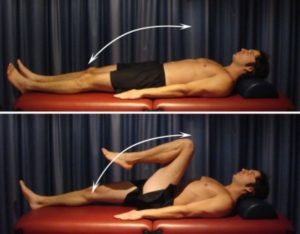
Single Leg Kicks
Begin this exercise lying on your stomach with your hands underneath your forehead as demonstrated (figure 3). Slowly bend the knee until the lower leg is pointing upwards. Lift your bent knee just a few inches off the floor without moving your lower back. Slowly straighten the knee, then lower the leg back down to the floor, returning to the starting position. Keep your spine and pelvis still throughout the exercise and breathe normally. Perform 10 repetitions on the affected leg provided the exercise is pain free.
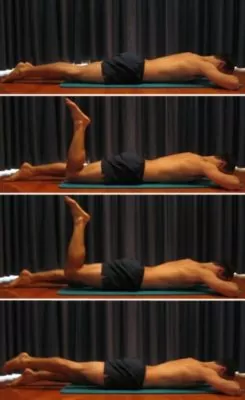
Hip Abduction Sidelying
Begin this exercise lying on your side with your legs together. Keeping your back and knee straight and foot facing forwards, slowly take your leg upwards tightening the muscles at the side of your thigh / hip (gluteals) (figure 4). Hold for 2 seconds and then return to the starting position. Perform 10 – 20 repetitions on each leg provided the exercise is pain free.
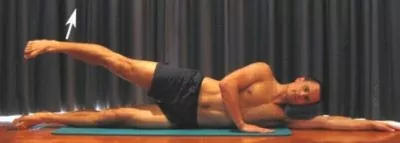
Intermediate Exercises

Members Only ContentBecome a PhysioAdvisor Member to gain full access to this exclusive content. For more details see Become a Member. Already a member? Login Now
Advanced Exercises

Members Only ContentBecome a PhysioAdvisor Member to gain full access to this exclusive content. For more details see Become a Member. Already a member? Login Now
Other Exercises

Members Only ContentBecome a PhysioAdvisor Member to gain full access to this exclusive content. For more details see Become a Member. Already a member? Login Now
Rehabilitation Protocol for a gluteal strain

Members Only ContentBecome a PhysioAdvisor Member to gain full access to this exclusive content. For more details see Become a Member. Already a member? Login Now
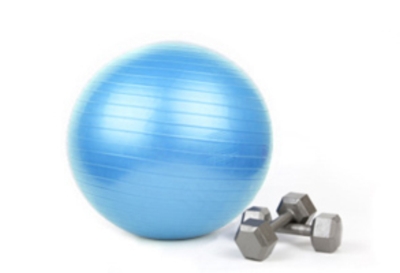 Physiotherapy products for a gluteal strain
Physiotherapy products for a gluteal strain
Some of the most commonly recommended products by physiotherapists to hasten healing and speed recovery in patients with this condition include:
To purchase physiotherapy products for a gluteal strain click on one of the above links or visit the PhysioAdvisor Shop.
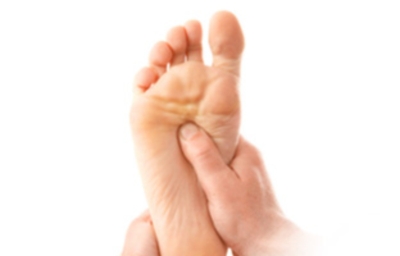 Find a Physio
Find a Physio
Find a physiotherapist in your local area who can treat a gluteal strain.
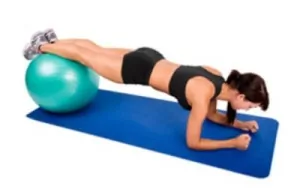
Other exercises
- Gluteal Stretches.
- Gluteal Strengthening Exercises.
- Leg Stretches.
- Leg Strengthening Exercises.
- Lower Body Gym Exercises (Machine Weights).
- Lower Body Free Weight Gym Exercises.
- Balance Exercises
- Beginner Pilates Exercises to improve core stability and posture.
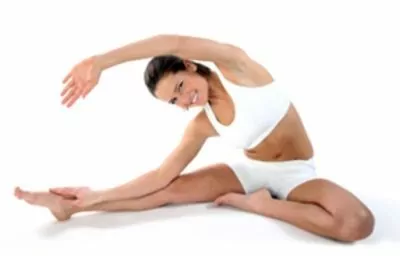 More information
More information
- View detailed information on initial injury management and the R.I.C.E. regime.
- Read comprehensive information on How to use Crutches.
- Learn when to use Ice or Heat.
- View our detailed Return to Running Program.
- Do I Need Orthotics?
- Learn key tips to prevent injury recurrence when Returning to Sport.
- Read our Buttock Pain Diagnosis Guide.
Become a PhysioAdvisor Member
-
 Individual Membership (12 Months)$59.95 for 1 year
Individual Membership (12 Months)$59.95 for 1 year -
 Individual Membership (3 Months)$39.95 for 3 months
Individual Membership (3 Months)$39.95 for 3 months -
 Individual Membership (Yearly)$49.95 / year
Individual Membership (Yearly)$49.95 / year -
 Individual Membership (Monthly)$15.95 / month
Individual Membership (Monthly)$15.95 / month

Link to this Page
If you would like to link to this article on your website, simply copy the code below and add it to your page:
<a href="https://physioadvisor.com.au/injuries/buttock/gluteal-strain”>Gluteal Strain – PhysioAdvisor.com</a><br/>PhysioAdvisor offers detailed physiotherapy information on a gluteal strain including: causes, symptoms, diagnosis, treatment, exercises and more...
Return to the top of Gluteal Strain.


